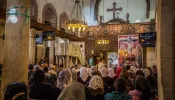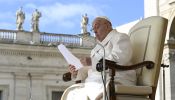Of the sacrifice of Christ, the main sign or figure of the sacrifice of Christ in the Old Testament is the paschal lamb. At every Passover, the Jews recalled and renewed their covenant with God by sacrificing a lamb. This sacrificial lamb once spared the firstborn of the Jews from the exterminating angel who came to slay the firstborn of every family in Egypt.
Our Lord anticipates his sacrifice on the cross in the Last Supper, within the Jewish ritual celebration of the Passover. In the Cenacle as on Calvary, the essential elements of the sacrifice are there: the immolation and self-offering (body and blood) to God the Father. Christ is the unspotted Lamb. He sets all people free from the slavery of sin and establishes the eternal alliance between creature and Creator, the New Covenant. More than that, what had been only a foreshadowing in sign is now fully realized: the communion of blood and of life between God and us.
When the faithful are said to offer Mass together with the priest, this does not mean that all the members of the Church, like the priest himself, perform the visible liturgical rite. This is done by the celebrant only. He has been divinely appointed for this purpose through the sacrament of Holy Orders.
The principal victim of the sacrifice, is Jesus Christ. But the faithful, in order to exercise their common priesthood fully, should unite their sacrifice to his and thus offer themselves, also, to God the Father: "I exhort you . . . to present your bodies as a sacrifice, living, holy, pleasing to God-your spiritual service," wrote St. Paul to the Romans. 2
The Mass "requires all Christians, so far as human power allows, to reproduce in themselves the sentiments that Christ had when he was offering himself in sacrifice: sentiments of humility, adoration, praise and thanksgiving to the divine Majesty. It requires them also to become victims, as it were, cultivating a spirit of self-denial according to the precepts of the Gospel, willingly doing works of penance, detesting and expiating their sins. It requires us all, in a word, to die mystically with Jesus Christ on the cross, so that we may say with the same apostle: ‘With Christ, I hang upon the cross.'" 3
--------------------------------------------------------------------------------
2. Romans 12:1.
3. Pius XII, Mediator Dei, Nov 20, 1942.
Printed with permission from eCatholic Hub.











